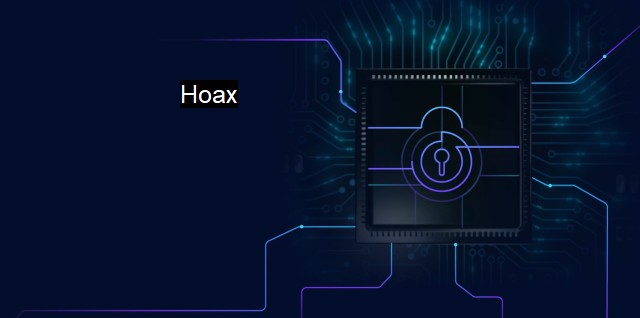What is Hoax?
Understanding the Dangers of Cyber Hoaxes: Manipulating Fears and Spreading Misinformation in the World of Cybersecurity
In the world of technology, and especially within the realms of cybersecurity and antivirus, the term "hoax" carries a very specific and potentially deadly meaning. Traditional usage would suggest a hoax entails an act of deception, played as a joke or deployed to dupe individuals into believing something that isn't real. In the cybersecurity landscape the hoax is no laughing matter and can carry very significant and serious repercussions.At its heart, a hoax, in the cybersecurity context, is a type of fraud scheme or scam that's deliberately designed to result in harm to victims. The damage could be financial or reputational, or can carry personal implications such as identity theft. Some hoaxes indeed have motives rooted in simple tomfoolery, yet the overwhelming majority aim to take advantage of tech users by evoking panic, eliciting private information, gaining fraudulent access or causing indirect harm.
One of the prominent hoaxes typically seen in the sphere of cybersecurity and antivirus was the infamous 'I love you' virus hoax that spread way back in 2000. Users were emailed with what seemed to be a love letter attached to lure them into opening it. The catch was, upon opening the 'letter', it unleashed a malicious code that propagated itself to everyone in the user's email directory, causing Chaos and wide-scale harm.
Hoaxes, today, are substantially more sophisticated and can take on various disguises. It might range from scam emails with malicious attachments or conspiracies about non-existent computer bugs, to fraudulent antivirus 'protection' promises that upon installation infect computer systems with malware. Highly evolved hoaxes even operate through social engineering where they design psychologically manipulative pathways to cheat users' trust and gain unauthorized access.
In the contemporary internet era, hoaxes utilize fear as their primary arsenal, feeding on the user's concern for their cybersecurity. The abundance of horror stories about identity thefts, system breaches, and data loss often propel even a discerning user to fall for these hoaxes in the hope to increase their security. The tricksters exploit this constant fear and panic by designing their scams accordingly.
Despite their formidable sounding nature, brute force prevention against hoaxes necessitates straightforward yet effective solutions. Besides utilizing a robust antivirus system in place, it's equally crucial to emphasize user awareness. Understanding the potential form and structure of a hoax, recognizing signs of scams, and incorporating healthy digital habits could significantly reduce the likelihood of falling prey to these hoaxes.
One must exercise skepticism while encountering unknown emails, downloaded files, links, or self-proclaimed protection software that boast of magical cybersecurity solutions. Blindly believing in such things without further investigation may lead a user into the depths of the hoax itself. Exploring the source's authenticity, keeping an eye on the language used, refraining from sharing personal or confidential data, and regularly updating antivirus software are simple yet extremely effective habits to protect oneself from hoaxes.
Summarizing the essence of 'hoax' in the antivirus and cybersecurity context underlines its dangerous capability to dupe, control and cause havoc. 'Hoax' transcends beyond its generic definition of mere deception and establishes itself as an enormous threat in the digital world, being a potent weapon in the arsenal of cyber frauds. although antigens are available against this virus of hoax, including robust software and a vigilant and skeptical mind, the evolving nature of hoaxes demands users to remain on constant alert.
The impunity provided by collective anonymity in the cybersphere lends a certain fearlessness to these hoax masters, validating Joseph Conrad's declaration that 'The belief in a supernatural source of evil is not necessary; men alone are quite capable of every wickedness.' Hoaxes are a perfect case in point of this destructive capability, as the tech-dependent world rhythmically accelerates with innovation, so too does the shadow of hoaxes that thrive on exploiting perceptions of risk and technological capabilities.

Hoax FAQs
What is a hoax in cybersecurity?
In cybersecurity, a hoax is a type of online deception that involves spreading false information or fake news with the goal of tricking people into taking certain actions or revealing personal information.What are some examples of hoaxes in cybersecurity?
Some examples of hoaxes in cybersecurity include phishing scams, fake antivirus software, and social engineering attacks.What can individuals do to protect themselves from hoaxes in cybersecurity?
Individuals can protect themselves from hoaxes in cybersecurity by being skeptical of any information that seems too good to be true, verifying the authenticity of emails or messages before clicking on links or providing personal information, and installing reputable antivirus software on their devices.Why are hoaxes dangerous in cybersecurity?
Hoaxes are dangerous in cybersecurity because they can lead to identity theft, financial fraud, and other types of cybercrime. Additionally, hoaxes can spread rapidly through social media and other online channels, making it difficult to contain the damage once the false information has been disseminated.| | A | | | B | | | C | | | D | | | E | | | F | | | G | | | H | | | I | | | J | | | K | | | L | | | M | |
| | N | | | O | | | P | | | Q | | | R | | | S | | | T | | | U | | | V | | | W | | | X | | | Y | | | Z | |
| | 1 | | | 2 | | | 3 | | | 4 | | | 7 | | | 8 | | |||||||